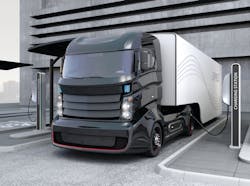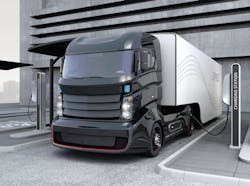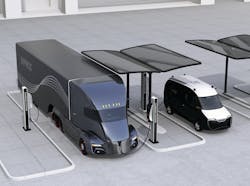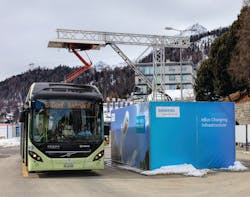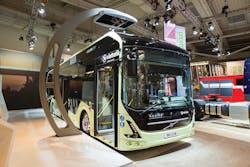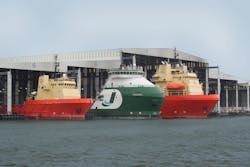When people think about electricity as a transportation fuel, they normally think about it in the context of moving people around by electric cars, trucks, mass transit and buses. However, there also is a growing interest in electricity as a more efficient and cost-effective transportation fuel for moving things, like shipping freight, last-mile delivery of goods and even powering seaports.
While it is true more consumers are buying personal electric vehicles (EVs) — an 81% increase from 2017 to 2018, according to the Edison Electric Institute (EEI) — some utilities are pursuing projects to electrify transport in other ways. Green fleets could cut emissions while costing 30% less to operate than combustion engine vehicles, but they also might require investing in some power grid upgrades to get them working properly.
Swedish automaker Volvo did a survey in 2018 that confirmed people are still concerned about EV range. In fact, 58% agreed they have range anxiety, in which they fear a vehicle has insufficient range to reach a given destination. People also are apprehensive about where the nearest charging station is, with 49% worried about charging availability. However, the automotive company itself is betting big on EVs. Volvo Trucks North America is rolling out its first Class 8 battery-electric vehicle in 2020 as a part of its Low Impact Green Heavy Transport Solutions (LIGHTS) program.
Powering Through Barriers
Keith Brandis, Volvo’s vice president of partnerships and strategic solutions, told attendees of EEI’s 2020 Virtual Leadership Summit on fleet electrification that electric trucking is taking off.
“The future is happening now. A couple years ago, there were start-ups and other companies that predicted that electric trucks would be right around the corner, and they failed. But for Volvo, a company of 100,000 people, to say we are going to go into heavy electric trucks … it’s happening and we’re saying now is the time to be having these plans about grid upgrades and charging infrastructure,” Brandis said.
There are barriers to overcome. For example, Brandis said in EV-friendly California, it can be hard to get public charging stations in place for heavy-duty trucks. There has been uncertainty about whether operators of EV service equipment are considered public utilities under the Public Utilities Code. Volvo has been working with other companies since 2019 to get clarification on this classification from the California Public Utilities Commission (CPUC). In August 2020, the companies asked the CPUC for “an exemption for medium- and heavy-duty EV charging services from classification as public utilities to address real concerns that are holding up the financing and completion of projects currently nearing completion, or in various phases of development and construction, to serve medium- and heavy-duty EVs. The CPUC issued a decision on Sept. 24, 2020, stating: “The providers of medium- and heavy-duty electric vehicle charging services, and off-road electric vehicle or off-road electric equipment charging services, are not public utilities.”
This clarification should help with the completion of more heavy-duty charging stations. Another reason this should be less of a barrier in the coming years is the California Air Resources Board (CARB) voted on June 25, 2020, to approve an Advanced Clean Trucks regulation. According to the new rule, every new truck sold in California will be zero emission by 2045. There also is a proposed requirement for larger fleets in the state to transition to electric trucks year over year.
Utilities such as San Diego Gas & Electric and others have filed with the CPUC for more support on deploying medium- and heavy-duty electric trucks. The CPUC began reviewing these applications in spring 2018 and continues to gather input from utilities and other stakeholders.
Another obstacle is the power grid itself. A large trucking distribution center would use a few hundred kilowatts mostly for lighting and some light-office activity. That same center, if it had a fleet of long-haul trucks to charge overnight, would now require electricity on the megawatt scale.
Russell Musgrove, managing director of global vehicles for FedEx, said his company recently ordered 1000 medium-duty all-electric panel vans from Chanje, a California-led, Chinese-based company. However, to reach the scale FedEx wants, more power will be needed, he noted.
“A lot of times, there’s just not enough energy and, when you talk about putting 150 [or] 100 electric vehicles inside a building, we’re having to be real creative with the kinds of charging systems we use,” Musgrove explained. “Right now, we’re actually having to scale back until we can get the kind of utility upgrades or microgrids to allow us to be able to have a whole facility using electricity as a vehicle fuel.”
Working with utilities requires a familiarity with things delivery companies usually do not have to think about, he added.
“We are now focusing on working with our utility partners, and utilities are a very complicated industry. …I come from a simple industry. We move packages around the world on a 24-hour cycle, but the utility industry — regulated, deregulated — is very complex,” Musgrove observed.
FedEx remains dedicated to proving the concept of electric shipping and delivery because the company believes electricity is the best fuel, according to Musgrove.
“I like to say we are energy agnostic, but in our duty cycle — in what we do, which is last-mile delivery — electricity is the most efficient energy source for a vehicle fuel that we could find,” Musgrove said.
Brandis believes battery technology for vehicles is evolving rapidly and offers big advantages over the long term, but up-front costs are still an issue.
“Seems like every 18 to 24 months, we see tremendous improvements in the efficiency and storage capacity of the battery, and the costs are coming down, but it still is the most expensive piece of a heavy-duty truck,” he explained. “It’s not just taking a diesel engine out and putting a battery in its place. It’s many times more expensive.”
Also at issue are end-of-life questions for this expensive hardware, which Brandis said must be part of the consideration for companies looking to invest in energy storage technology.
“We are also having to think about how do we get a second life for these very expensive components. What happens when the deterioration of the battery gets to such a point that it needs to be replaced? We are looking at how older batteries can have a second life providing power support to multifamily dwellings and apartment buildings,” Brandis noted.
Marine Electrification
A tremendous amount of shipping is still done with ships crossing oceans. At any given time, there are at least 20 million shipping containers floating across the world’s oceans. When the ships are in port, typically they must run their auxiliary engines. However, it is possible to retrofit ships to accept electricity from the power grid.
At Louisiana’s Port Fourchon, the state’s southernmost port, Entergy Services LLC and its innovation center, KeyString Labs, conducted their first shore power installation project. This port sits on the Gulf of Mexico and services some 90% of the Gulf’s deepwater oil production, making the facility essential infrastructure of nationwide importance.
Entergy’s shore power project works a bit like a miniature parking lot with charging stations for ships. It allows large platform supply vessels to park dockside and use grid power without having to burn fuel and run their engines. This is quieter, cleaner and cheaper than using auxiliary engines, and it causes no wear and tear on ship engines. To reap all these benefits, however, grid upgrades were necessary.
Existing power distribution lines had to be extended to reach closer to the shore, and 750-kV step-down transformers were mounted on platforms. Ship engineers plug a custom extension cord to the ship’s electrical bus when power is needed, then signal onboard equipment to stop drawing power from the engines. Entergy also presided over a power quality test to ensure voltage stayed consistent while the ships drew power.
Entergy believes this application could be used in future projects. The utility already has changed its distribution standards to accommodate permitting for shore power projects. From a construction standpoint, Entergy developed a plan to lift five transformers to the special platforms along the shore and learned to bring the design and construction teams together during early project stages.
Edison Chouest Offshore, the marine transportation company whose vessels now charge while docking at Port Fourchon, had used smaller-scale shore power applications before. This kind of cross-industry cooperation and sharing of expertise could serve as a lesson for future projects as well as other transport electrification use cases.
Moving Freight with Electricity
Dallas/Fort Worth, Texas, U.S., is a crossroads not just for air travelers, but also for freight moving across land and air. The airport, which is the size of the island of Manhattan, shipped 971,000 tons of cargo in fiscal year 2019. Texas is synonymous with fossil fuel production and processing, but if a major world trade hub like DFW saw a major disruption in the oil and gas sector, all those goods coming and going through Texas might have a serious problem.
Dallas-based Oncor Electric Delivery Co., a public utility serving 10 million Texans, is thinking about what electrification could have to offer DFW. To enable more electric transportation, distribution centers are going to need more power.
T&D World contributor David Treichler, director of strategy and technology for Oncor Electric Delivery, said most distribution centers only use about 200 kW or less for lighting and offices. Fueling a fleet of about 40 Class 6 or Class 8 electric heavy-duty trucks would require around 9 MW. Current loads are an order of magnitude smaller than they would be in a distribution center that could charge electric trucks. Furthermore, if the distribution centers are clustered together to be close to transportation infrastructure, like airports and highways, the same substation might see its load rise dramatically.
Utilities interested in jumping into this kind of electrification may find themselves having to get familiar with how the logistics industry works. Treichler said Oncor found that fleet transition to electrification will be an annual load increase utilities will need to anticipate. Also, equipment manufacturers are considering different charging use cases for their vehicles. The overnight charging model uses lower-level direct-current (dc) fast chargers. However, trucks standing still to charge do not make any money. By using higher kilowatt dc fast charge, another model is to charge trucks as they are loading and unloaded at the depot. Depending on how the distribution center operates, either model could lead to higher peak-time loads.
Oncor developed a fleet analytics tool, called FleetSeek, and deployed it in the Dallas/Fort Worth area to gather data on the movements of trucks, their charging times, their impacts on residential feeders in the area and other data. The tool keeps track of some 21,600 fleets — some with two vehicles and some with hundreds. The utility believes green fleets could have a big impact on the power grid and even determine its future upgrades and growth as time goes by and more data is gathered.
Utility Partners
Russell Musgrove said FedEx is no longer in the “science project” phase of electrifying its fleet. The company already has seen enough data to be convinced electricity is an efficient fuel for delivering packages. What it needs now are dedicated utility partners.
“I’ve been blessed to do some amazing projects with some utility companies on both the East and West Coasts,” Musgrove said. “Some were true business partners, and some others were kind of my way or the highway.”
Some utilities have gotten into the conservation mindset and electrified transportation consumes much more electricity in a sector where there used to be not much demand. Musgrove said all stakeholders need to get in the same room and understand one another’s needs.
FedEx wants to expand its electric-powered fleet to tens of thousands of vehicles as quickly as possible, Musgrove said, adding that he does not want to keep things small.
“We need to find OEMs and other start-ups that are becoming serious about getting to some level of scalability for tens of thousands of trucks as opposed to 100 here and 100 there,” he explained.
These projects constitute a bigger step than they may seem. Electrifying operations at these sites goes far beyond a few charging stations at the local strip mall or a solar-powered parking lot on a college campus. Port Fourchon and DFW are critical infrastructure for the U.S., and a disruption at either could have wide-ranging economic consequences. This is a lot to trust the utility sector with, and it speaks highly of the trust stakeholders have in this industry to be tasked with such important jobs. If utilities can work together with everyone concerned, the way work gets done in the U.S. could be powered differently.
Jeff Postelwait ([email protected]) is managing editor for Utility Products Magazine, a sister publication to T&D World Magazine.
For more information:
Chanje | www.chanje.com
Edison Chouest Offshore | www.chouest.com
Edison Electric Institute | www.eei.org
Entergy Services LLC | www.entergy.com
FedEx | www.fedex.com
Oncor Electric Delivery | www.oncor.com
San Diego Gas & Electric | www.sdge.com
Volvo | www.volvocars.com
About the Author
Jeff Postelwait
Managing Editor
Jeff Postelwait is a writer and editor with a background in newspapers and online editing who has been writing about the electric utility industry since 2008. Jeff is senior editor for T&D World magazine and sits on the advisory board of the T&D World Conference and Exhibition. Utility Products, Power Engineering, Powergrid International and Electric Light & Power are some of the other publications in which Jeff's work has been featured. Jeff received his degree in journalism news editing from Oklahoma State University and currently operates out of Oregon.
